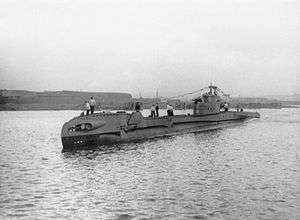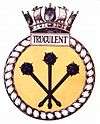HMS Truculent (P315)
 HMS Truculent at Barrow in December 1942 | |
| History | |
|---|---|
| Name: | HMS Truculent |
| Builder: | Vickers Armstrong, Barrow |
| Laid down: | 4 December 1941 |
| Launched: | 12 September 1942 |
| Commissioned: | 31 December 1942 |
| Fate: | accidentally sunk 12 January 1950 |
| Badge: |
 |
| General characteristics | |
| Class and type: | T-class submarine |
| Displacement: |
|
| Length: | 276 ft 6 in (84.28 m) |
| Beam: | 25 ft 6 in (7.77 m) |
| Draught: |
|
| Installed power: |
|
| Propulsion: |
|
| Speed: |
|
| Range: | 4,500 nmi (5,200 mi; 8,300 km) at 11 kn (13 mph; 20 km/h) (surfaced) |
| Test depth: | 300 ft (91 m) max |
| Complement: | 61 |
| Armament: |
|
HMS Truculent was a British submarine of the third group of the T class. She was built as P315 by Vickers Armstrong, Barrow, and launched on 12 September 1942. Truculent was lost following a post-war accident with a Swedish oil tanker in the Thames Estuary in January 1950.
Wartime service
Truculent spent much of her World War II wartime service in the Pacific Far East, except for a period in early 1943, operating in home waters. Here, she sank the German submarine U-308, on her first war patrol, with all hands. She also took part in Operation Source, towing the X-class midget submarine X-6 to Norway to attack the heavy Kriegsmarine warships Tirpitz, Scharnhorst and Lützow.
On her transfer to the Pacific, she sank the Japanese army cargo ship Yasushima Maru; the small Japanese vessel Mantai; the Japanese merchant cargo ship, turned hell ship, Harugiku Maru and five Japanese sailing vessels. She also laid mines, one of which damaged the Japanese minelayer Hatsutaka.[1]
She survived the war and returned to the United Kingdom to continue in service with the Royal Navy.
Sinking
On 12 January 1950, Truculent was returning to Sheerness, having completed trials after a refit at Chatham. In addition to her normal complement, she was carrying an additional 18 dockyard workers. She was travelling through the Thames Estuary at night. At 19:00, a ship showing three lights appeared ahead in the channel. It was decided that the ship must be stationary, and because Truculent could not pass to the starboard side without running aground, the order was given to turn to port. At once, the situation became clear; the Swedish oil tanker Divina — on passage from Purfleet and bound for Ipswich — came out of the darkness. The extra light indicated that she was carrying explosive material. The two vessels collided and remained locked together for a few seconds before the submarine sank.[2]
Fifty-seven of her crew were swept away in the current after a premature escape attempt, 15 survivors were picked up by a boat from the Divina and five by the Dutch ship Almdijk. Most of the crew survived the initial collision and managed to escape, but then perished in the freezing cold mid-winter conditions on the mud islands that litter the Thames Estuary. Sixty-four men died as a result of the collision. Truculent was salvaged on 14 March 1950 and beached at Cheney Spit. The wreck was moved inshore the following day where 10 bodies were recovered. She was refloated on 23 March and towed into Sheerness Dockyard. An inquiry attributed 75% of the blame to Truculent and 25% to Divina.
Truculent was then sold to be broken up for scrap on 8 May 1950.
Her loss led Peter de Neumann of the Port of London Authority to develop plans for a port control system, and the later introduction of the 'Truculent light', an extra steaming all round white light on the bow, on British submarines, to ensure they remained highly visible to other ships.
In Film
On 21 February 1950, the film "Morning Departure" was released. The film tells the story of a British submarine that sinks on a training cruise from the perspective of a small group of survivors. Filming finished shortly before HMS Truculent sank, and the film was almost withdrawn. The decision was made to release the film as planned, and to add the following message that appears in the opening credits:
This film was completed before the tragic loss of HMS Truculent, and earnest consideration has been given as to the desirability of presenting it so soon after this grievous disaster. The Producers have decided to offer the film in the spirit in which it was made, as a tribute to the officers and men of H.M. Submarines, and to the Royal Navy of which they are a part.
See also
References
- ↑ HMS Truculent, Uboat.net
- ↑ Submarine losses 1904 to present day, RN Submarine Museum, Gosport
Publications
- Colledge, J. J.; Warlow, Ben (2006) [1969]. Ships of the Royal Navy: The Complete Record of all Fighting Ships of the Royal Navy (Rev. ed.). London: Chatham Publishing. ISBN 978-1-86176-281-8. OCLC 67375475.
- Hutchinson, Robert (2001). Jane's Submarines: War Beneath the Waves from 1776 to the Present Day. London: HarperCollins. ISBN 978-0-00-710558-8. OCLC 53783010.